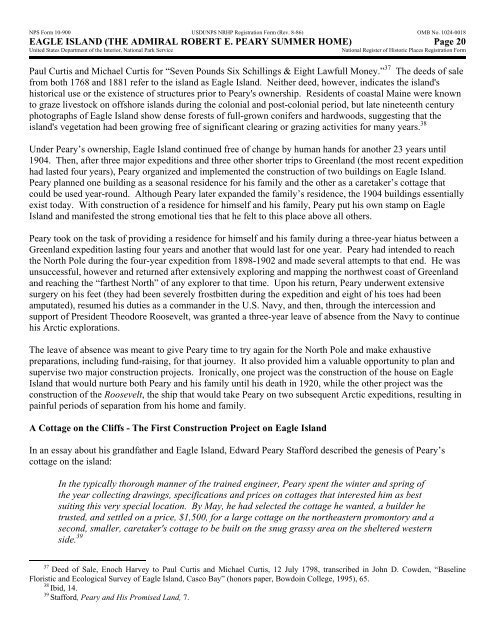Nomination - National Park Service
Nomination - National Park Service
Nomination - National Park Service
Create successful ePaper yourself
Turn your PDF publications into a flip-book with our unique Google optimized e-Paper software.
NPS Form 10-900 USDI/NPS NRHP Registration Form (Rev. 8-86) OMB No. 1024-0018<br />
EAGLE ISLAND (THE ADMIRAL ROBERT E. PEARY SUMMER HOME) Page 20<br />
United States Department of the Interior, <strong>National</strong> <strong>Park</strong> <strong>Service</strong><br />
<strong>National</strong> Register of Historic Places Registration Form<br />
Paul Curtis and Michael Curtis for “Seven Pounds Six Schillings & Eight Lawfull Money.” 37 The deeds of sale<br />
from both 1768 and 1881 refer to the island as Eagle Island. Neither deed, however, indicates the island's<br />
historical use or the existence of structures prior to Peary's ownership. Residents of coastal Maine were known<br />
to graze livestock on offshore islands during the colonial and post-colonial period, but late nineteenth century<br />
photographs of Eagle Island show dense forests of full-grown conifers and hardwoods, suggesting that the<br />
island's vegetation had been growing free of significant clearing or grazing activities for many years. 38<br />
Under Peary’s ownership, Eagle Island continued free of change by human hands for another 23 years until<br />
1904. Then, after three major expeditions and three other shorter trips to Greenland (the most recent expedition<br />
had lasted four years), Peary organized and implemented the construction of two buildings on Eagle Island.<br />
Peary planned one building as a seasonal residence for his family and the other as a caretaker’s cottage that<br />
could be used year-round. Although Peary later expanded the family’s residence, the 1904 buildings essentially<br />
exist today. With construction of a residence for himself and his family, Peary put his own stamp on Eagle<br />
Island and manifested the strong emotional ties that he felt to this place above all others.<br />
Peary took on the task of providing a residence for himself and his family during a three-year hiatus between a<br />
Greenland expedition lasting four years and another that would last for one year. Peary had intended to reach<br />
the North Pole during the four-year expedition from 1898-1902 and made several attempts to that end. He was<br />
unsuccessful, however and returned after extensively exploring and mapping the northwest coast of Greenland<br />
and reaching the “farthest North” of any explorer to that time. Upon his return, Peary underwent extensive<br />
surgery on his feet (they had been severely frostbitten during the expedition and eight of his toes had been<br />
amputated), resumed his duties as a commander in the U.S. Navy, and then, through the intercession and<br />
support of President Theodore Roosevelt, was granted a three-year leave of absence from the Navy to continue<br />
his Arctic explorations.<br />
The leave of absence was meant to give Peary time to try again for the North Pole and make exhaustive<br />
preparations, including fund-raising, for that journey. It also provided him a valuable opportunity to plan and<br />
supervise two major construction projects. Ironically, one project was the construction of the house on Eagle<br />
Island that would nurture both Peary and his family until his death in 1920, while the other project was the<br />
construction of the Roosevelt, the ship that would take Peary on two subsequent Arctic expeditions, resulting in<br />
painful periods of separation from his home and family.<br />
A Cottage on the Cliffs - The First Construction Project on Eagle Island<br />
In an essay about his grandfather and Eagle Island, Edward Peary Stafford described the genesis of Peary’s<br />
cottage on the island:<br />
In the typically thorough manner of the trained engineer, Peary spent the winter and spring of<br />
the year collecting drawings, specifications and prices on cottages that interested him as best<br />
suiting this very special location. By May, he had selected the cottage he wanted, a builder he<br />
trusted, and settled on a price, $1,500, for a large cottage on the northeastern promontory and a<br />
second, smaller, caretaker's cottage to be built on the snug grassy area on the sheltered western<br />
side. 39<br />
37<br />
Deed of Sale, Enoch Harvey to Paul Curtis and Michael Curtis, 12 July 1798, transcribed in John D. Cowden, “Baseline<br />
Floristic and Ecological Survey of Eagle Island, Casco Bay” (honors paper, Bowdoin College, 1995), 65.<br />
38<br />
Ibid, 14.<br />
39<br />
Stafford, Peary and His Promised Land, 7.
















